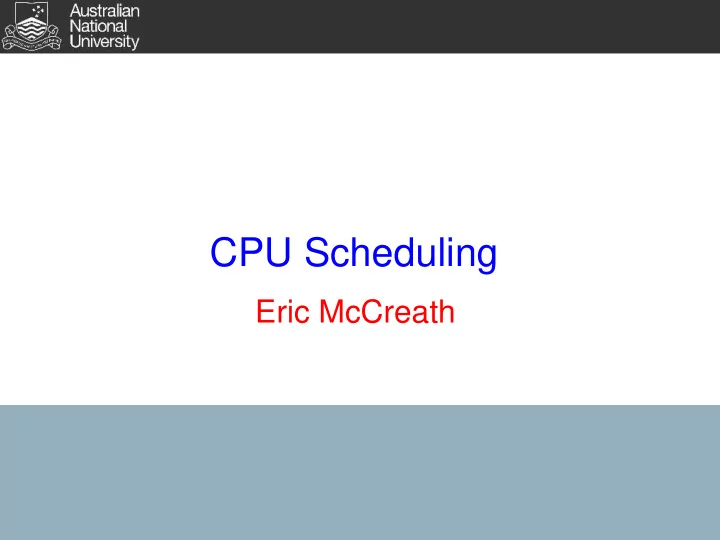

CPU Scheduling Eric McCreath
Introduction CPU scheduling is at the heart of a multiprogrammed operating system. The CPU scheduler maintains the list of ready processes and determines when and which process is to be allocated to a CPU. A process during its life will go through a cycle of CPU execution and I/O waiting. 2
Introduction There are two types of schedulers: non-preemptive - The CPU is not 'forcefully' taken from the process, and a preemptive - The CPU may be forcefully taken from the process and switched to another process. 3
Scheduling Criteria A variety of criteria are used to compare different scheduling algorithms. These include: CPU utilization - The percentage of time the CPU is in use. Throughput - The rate at which processes are being completed. Turnaround time - The interval of time from the starting a process to completing the process. Wait time - The amount of time a process spends in the ready queue. Response time - The amount of time it takes a process to start responding. This does not include the time to output the response. 4
FCFS Scheduling The simplest scheduling algorithm is the First Come First Serve (FCFS) scheduler. It works by maintaining a FIFO queue. When the running process has completed its CPU burst the next process on the ready queue is dispatched. Processes that are either new or have completed their IO burst are placed on the end of the queue. A disadvantage of a FCFS scheduler is IO bound processes will build up behind CPU bound process. This is known as the convoy effect. This will reduce both IO and CPU utilisation. 5
SJF Scheduling The shortest-job-first (SJF) algorithm schedules the process with the shortest next CPU burst time. If the next CPU burst time of two process is identical then a FCFS scheduler will be used to break the tie. The SJF scheduler is provably optimal with respect to minimizing average waiting time for a set of processes. There is generally no way of knowing the length of the next CPU burst. Hence, it is impossible to implement a SJF CPU scheduler. 6
Round Robin Scheduling A round robin scheduler is a FCFS scheduling where process are preempted after a fix time slice (or time quantum) and placed at the end of the FIFO queue. The ready queue may be thought of as a circular queue. The average wait time for a RR scheduler is comparatively longer than SJF scheduling. A round robin scheduler is useful for time-sharing systems. If the time quantum is infinite then RR scheduling is the same as FCFS scheduling. Determining the size of the time quantum is critical. The smaller the time quantum the greater the context switching overhead. 7
Example Given the below table calculate the average wait time for FCFS, SJF (non-pre-emptive), SJF (pre-emptive), and Round Robin (time quantum = 4) scheduing approaches. 8
Recommend
More recommend